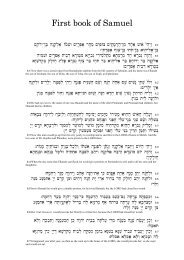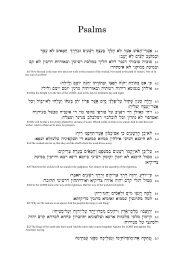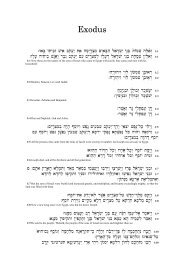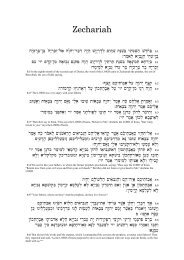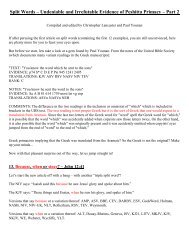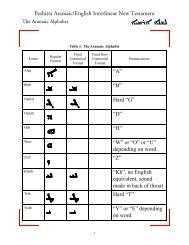ana translation
Untitled - Peshitta Aramaic/English Interlinear New Testament
Untitled - Peshitta Aramaic/English Interlinear New Testament
- No tags were found...
Create successful ePaper yourself
Turn your PDF publications into a flip-book with our unique Google optimized e-Paper software.
xlviii<br />
INTRODUCTION<br />
our Four, beginning with 2 and 3 John ;<br />
2 Peter breaks oft' in ii. 4,<br />
and Jude is lost ;<br />
then (after a gap) come the Pauline Epistles. It is<br />
probably a century later than Cod. 4 but its ;<br />
text, though intermediate<br />
like that of Cod. 4, exhibits a larger proportion of A-readings, some of<br />
them important, as for example the JSO1 for fovSl of 2 Pet. ii. 1.<br />
The MS is furnished all through with marginal variant readings, some<br />
from the Harklensian (see note *, p. 101 infr.).*<br />
Neither of these MSS yields any note of place. Apart from them<br />
stands another group (Codd. 3, 11, 13, 20), likewise intermediate in<br />
textual character, all of the fifteenth century, and all tending more<br />
than 4 and 5 to the A-text.<br />
(6) Of Fifteenth century.<br />
Cod. 3. (Br. M., Add. 17226, Catal cxxiv.)<br />
This MS contained, when entire, the Acts and Catholic Epistles, the<br />
Four being subjoined to the Three, but has unfortunately lost most of<br />
the Acts, and the end of Jude, breaking<br />
off in ver. 20. No note of<br />
time or place is now forthcoming, but it is<br />
probably of the fourteenth<br />
century. Its text is appreciably nearer to the A-type than that of<br />
Cod. 5, and it shows in places a distinct affinity with Cod. 1 (as, e.g.,<br />
in Jud. 7), repeating even its errors, as in 2 Pet. iii. 2 (.Ol-S^O), iii. 7<br />
But it follows the A-text in 2 Pet.<br />
(^AflDl).<br />
ii. 1, 10, 11, 17, 18,<br />
though not in omitting the negative in iii. 10.<br />
Cod. 11. (The "Williams MS.") This MS (Acts and Epistles)<br />
is<br />
now in the possession of Mr. Robert S. Williams, of Utica, New York.<br />
It was acquired by his brother, a missionary at Mardin ;<br />
and an Arabic<br />
note records that it was written at Hesna d' Kipha, in Tur-'Abdin, in<br />
A.Gr. 1782 (= A.D. 1471). It is thus locally connected with group A,<br />
especially with Cod. 12. It was copied for the owner, David of El-Homs<br />
(in the Lebanon country), from a MS acquired by him']' at El-Keifa<br />
* Also its corrections of 2 Pet. ii. 4, 2 Job. 10 (see pp. 103, 121, infr.), may be<br />
Harklensian.<br />
f If Dr. Hall rightly interprets the words of this David, the original of this MS<br />
which concludes it. He<br />
was a compilation by the unnamed writer of a poem<br />
suggests that this writer may have been one of the Christians of the [Syro-Indian]<br />
Church of Malabar, but does not state what the " indications " are which (as he<br />
says) " favour this conjecture." It seems improbable and the fact that the<br />
;<br />
compilation includes Prooemia taken from the Horreum Mysteriorum of Gregory<br />
bar-Ebraya (ob. A.D. 1286), marks it as the work of a Jacobite, probably not earlier<br />
than the fourteenth century. I have not found El-Keifa elsewhere mentioned.



